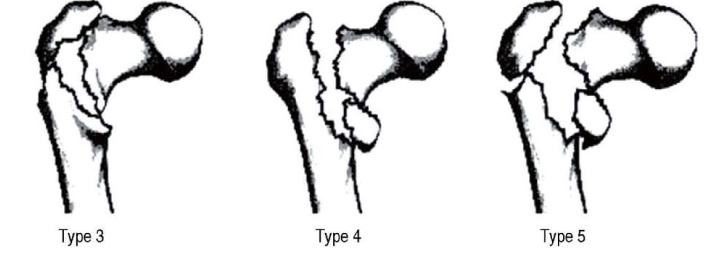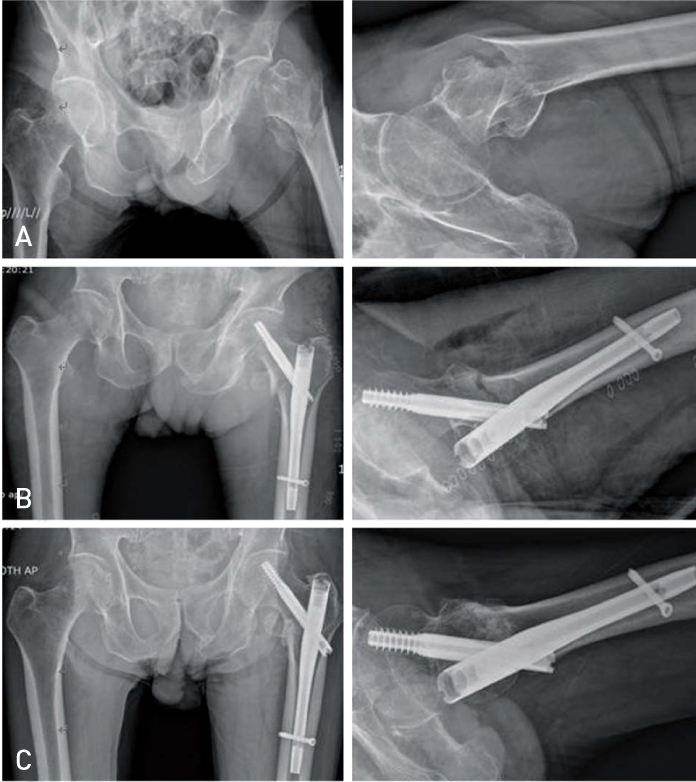Hip Pelvis.
2013 Dec;25(4):280-285. 10.5371/hp.2013.25.4.280.
The Antero-medial Cortex Overlapped Reduction of Unstable Intertrochanteric Fractures
- Affiliations
-
- 1Department of Orthopedic Surgery, College of Medicine, Wonkwang University, Iksan, Korea. osksh@wku.ac.kr
- 2Department of Orthpaedic Surgery, St. Carollo Hospital, Suncheon, Korea.
- 3Joint Replacement Center, Iksan Hospital, Iksan, Korea.
- KMID: 1808136
- DOI: http://doi.org/10.5371/hp.2013.25.4.280
Abstract
- PURPOSE
The purpose of this article is to evaluate the result of treatment of unstable intertrochanteric fractures by lateralization of distal fragment and antero-medial cortex contact of the distal shaft piece.
MATERIALS AND METHODS
We conducted an analysis of 20 cases of unstable intertrochanteric fractures treated using a gamma-3 nail from August 2011 to August 2012 and followed up for more than one year. Using postoperative and last follow-up radiographs, we measured NSA, TAD, Cleveland index, sliding length of the lag screw, and union time. Adequacy of reduction was assessed by a modification in the criteria of Baumgaertner and classified as good, acceptable, or poor.
RESULTS
The mean NSA was 140degrees postoperative and 135degrees at last follow-up. The mean TAD was 11.3 mm. The position of the lag screw was in center-center in 12 cases, center-inferior in eight cases. The mean distance of lag screw sliding was 5.5 mm at last follow-up. The mean union time was 3.7 months. The state of reduction postoperatively was good in 15 cases, and acceptable in five cases. There was no failure of reduction, lag screw cut-out, or other complications at last follow-up.
CONCLUSION
The reduction method for lateralization of distal fragment and antero-medial cortex contact of the distal shaft piece in an unstable intertrochanteric fracture is very useful for prevention of collapse of the fracture site, lag screw cut-out, and mechanical failure.
MeSH Terms
Figure
Reference
-
1. Cho MR, Lee SH, Cho DW, Ko SB. Treatment of unstable intertrochanteric fractures of the femur using an anti-hypersliding compression hip screw and TSP. J Korean Hip Soc. 2012; 24:37–44.
Article2. Kim BS, Cho DY, Yoon HK, et al. Common modes of fixation failure with a sliding hip screw encountered unstable intertrochanteric fracture. J Korean Soc Fract. 2003; 16:15–21.
Article3. Laros GS, Moore JF. Complication of fixation in intertrochanteric fractures. Clin Orthop Relat Res. 1974; (101):110–119.4. Lee KJ. Fixation failure of proximal femoral nail antirotation in femoral intertrochanteric fracture. Hip Pelvis. 2012; 24:302–308.
Article5. Carr JB. The anterior and medial reduction of intertrochanteric fractures: a simple method to obtain a stable reduction. J Orthop Trauma. 2007; 21:485–489.
Article6. Larsson S, Friberg S, Hansson LI. Trochanteric fractures. Influence of reduction and implant position on impaction and complications. Clin Orthop Relat Res. 1990; (259):130–139.7. Jensen JS. Classification of trochanteric fractures. Acta Orthop Scand. 1980; 51:803–810.
Article8. Doppelt SH. The slidning compression screw--today's best answer for stabilization of intertrochanteric hip fractures. Orthop Clin North Am. 1980; 11:507–523.
Article9. Cleveland M, Bosworth DM, Thompson FR, Wilson HJ Jr, Ishizuka T. A ten-year analysis of intertrochanteric fractures of the femur. J Bone Joint Surg Am. 1959; 41-A:1399–1408.
Article10. Fogagnolo F, Kfuri M Jr, Paccola CA. Intramedullary fixation of pertrochanteric hip fracture with the short AO-ASIF proximal femoral nail. Arch Orthop Trauma Surg. 2004; 124:31–37.
Article11. Parker MJ, Palmer CR. A new mobility score for predicting mortality after hip fracture. J Bone Joint Surg Br. 1993; 75:797–798.
Article12. Parker MJ. Trochanteric hip fractures. Fixation failure commoner with femoral medialization, a comparison of 101 cases. Acta Orthop Scand. 1996; 67:329–332.
Article13. Pajarinen J, Lindahl J, Savolainen V, Michelsson O, Hirvensalo E. Femoral shaft medialisation and neck-shaft angle in unstable pertrochanteric femoral fractures. Int Orthop. 2004; 28:347–353.
Article14. Kokoroghiannis C, Aktselis I, Deligeorgis A, Fragkomichalos E, Papadimas D, Pappadas I. Evolving concepts of stability and intramedullary fixation of intertrochanteric fractures--a review. Injury. 2012; 43:686–693.
Article15. Baumgaertner MR, Curtin SL, Lindskog DM, Keggi JM. The value of the tip-apex distance in predicting failure of fixation of peritrochanteric fractures of the hip. J Bone Joint Surg Am. 1995; 77:1058–1064.
Article16. De Bruijn K, den Hartog D, Tuinebreijer W, Roukema G. Reliability of predictors for screw cutout in intertrochanteric hip fractures. J Bone Joint Surg Am. 2012; 94:1266–1272.
Article17. Davis TR, Sher JL, Checketts RG, Porter BB. Intertrochanteric fractures of the femur: a prospective study comparing the use of the Küntscher-Y nail and sliding hip screw. Injury. 1988; 19:421–426.
Article18. Kyle RF, Gustilo RB, Premer RF. Analysis of six hundred and twenty-two intertrochanteric hip fractures. J Bone Joint Surg Am. 1979; 61:216–221.
Article19. Mulholland RC, Gunn DR. Sliding screw plate fixation of intertrochanteric femoral fractures. J Trauma. 1972; 12:581–591.
Article20. Tsukada S, Okumura G, Matsueda M. Postoperative stability on lateral radiographs in the surgical treatment of pertrochanteric hip fractures. Arch Orthop Trauma Surg. 2012; 132:839–846.
Article21. Kuzyk PR, Zdero R, Shah S, Olsen M, Waddell JP, Schemitsch EH. Femoral head lag screw position for cephalomedullary nails: a biomechanical analysis. J Orthop Trauma. 2012; 26:414–421.22. Hsueh KK, Fang CK, Chen CM, Su YP, Wu HF, Chiu FY. Risk factors in cutout of sliding hip screw in intertrochanteric fractures: an evaluation of 937 patients. Int Orthop. 2010; 34:1273–1276.
Article23. Pervez H, Parker MJ, Vowler S. Prediction of fixation failure after sliding hip screw fixation. Injury. 2004; 35:994–998.
Article24. Apel DM, Patwardhan A, Pinzur MS, Dobozi WR. Axial loading studies of unstable intertrochanteric fractures of the femur. Clin Orthop Relat Res. 1989; (246):156–164.
Article25. Sarmiento A. Unstable intertrochteric fractures of the femur. Clin Orthop Relat Res. 1973; (92):77–85.26. Andruszkow H, Frink M, Frömke C, et al. Tip apex distance, hip screw placement, and neck shaft angle as potential risk factors for cut-out failure of hip screws after surgical treatment of intertrochanteric fractures. Int Orthop. 2012; 36:2347–2354.
Article
- Full Text Links
- Actions
-
Cited
- CITED
-
- Close
- Share
- Similar articles
-
- Medial Displacement and Valgus Nailing with Jewett Nail in Unstable Intertrochanteric Fracture
- Treatment of Unstable Interochanteric Femoral Fracture using Compression Hip Screw with additional Transfixations Screw
- The Effects of Extramedullary Reduction in Unstable Intertrochanteric Fracture: A Biomechanical Study Using Cadaver Bone
- Treatment of Unstable Intertrochanteric Fractures of the Femur - Comparative analysis of the postero-medial fixation with or without additional screw -
- Fixation Failure of Unstable Intertrochanteric Fracture of the Femur Using Compression Hip Screw




